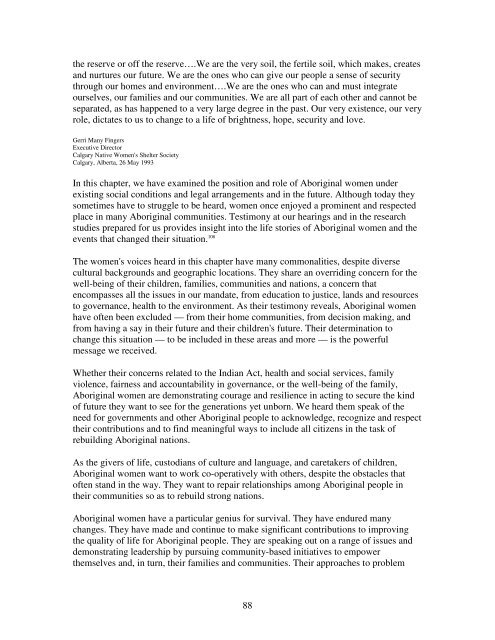2. Women's Perspectives - Christian Aboriginal Infrastructure ...
2. Women's Perspectives - Christian Aboriginal Infrastructure ...
2. Women's Perspectives - Christian Aboriginal Infrastructure ...
You also want an ePaper? Increase the reach of your titles
YUMPU automatically turns print PDFs into web optimized ePapers that Google loves.
the reserve or off the reserve….We are the very soil, the fertile soil, which makes, creates<br />
and nurtures our future. We are the ones who can give our people a sense of security<br />
through our homes and environment….We are the ones who can and must integrate<br />
ourselves, our families and our communities. We are all part of each other and cannot be<br />
separated, as has happened to a very large degree in the past. Our very existence, our very<br />
role, dictates to us to change to a life of brightness, hope, security and love.<br />
Gerri Many Fingers<br />
Executive Director<br />
Calgary Native <strong>Women's</strong> Shelter Society<br />
Calgary, Alberta, 26 May 1993<br />
In this chapter, we have examined the position and role of <strong>Aboriginal</strong> women under<br />
existing social conditions and legal arrangements and in the future. Although today they<br />
sometimes have to struggle to be heard, women once enjoyed a prominent and respected<br />
place in many <strong>Aboriginal</strong> communities. Testimony at our hearings and in the research<br />
studies prepared for us provides insight into the life stories of <strong>Aboriginal</strong> women and the<br />
events that changed their situation. 108<br />
The women's voices heard in this chapter have many commonalities, despite diverse<br />
cultural backgrounds and geographic locations. They share an overriding concern for the<br />
well-being of their children, families, communities and nations, a concern that<br />
encompasses all the issues in our mandate, from education to justice, lands and resources<br />
to governance, health to the environment. As their testimony reveals, <strong>Aboriginal</strong> women<br />
have often been excluded — from their home communities, from decision making, and<br />
from having a say in their future and their children's future. Their determination to<br />
change this situation — to be included in these areas and more — is the powerful<br />
message we received.<br />
Whether their concerns related to the Indian Act, health and social services, family<br />
violence, fairness and accountability in governance, or the well-being of the family,<br />
<strong>Aboriginal</strong> women are demonstrating courage and resilience in acting to secure the kind<br />
of future they want to see for the generations yet unborn. We heard them speak of the<br />
need for governments and other <strong>Aboriginal</strong> people to acknowledge, recognize and respect<br />
their contributions and to find meaningful ways to include all citizens in the task of<br />
rebuilding <strong>Aboriginal</strong> nations.<br />
As the givers of life, custodians of culture and language, and caretakers of children,<br />
<strong>Aboriginal</strong> women want to work co-operatively with others, despite the obstacles that<br />
often stand in the way. They want to repair relationships among <strong>Aboriginal</strong> people in<br />
their communities so as to rebuild strong nations.<br />
<strong>Aboriginal</strong> women have a particular genius for survival. They have endured many<br />
changes. They have made and continue to make significant contributions to improving<br />
the quality of life for <strong>Aboriginal</strong> people. They are speaking out on a range of issues and<br />
demonstrating leadership by pursuing community-based initiatives to empower<br />
themselves and, in turn, their families and communities. Their approaches to problem<br />
88
















